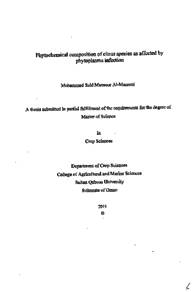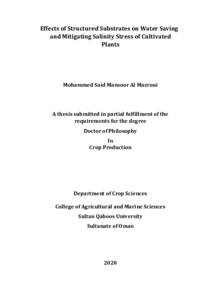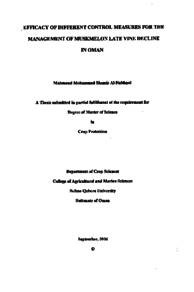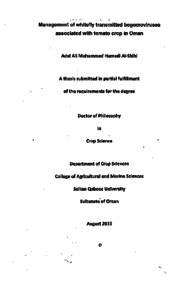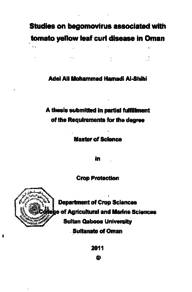Document
Phytochemical composition of citrus species as affected by phytoplasma infection
Publisher
جامعة السلطان قابوس
Gregorian
2015
Language
English
Subject
English abstract
Acid lime (Citrus aurantifolia, Swingle) is one of the major fruit crops in Oman. Other citrus species grown in Oman, albeit at smaller scale, include orange, grapefruit, sweet lime, and either seedlings or grafted on a variety of experimental rootstocks that include acid lime, macrophylla, rangpur lime, and rough lemon. The production of acid lime, also called Omani lime, has been significantly reduced in the last three decades due to the presence of witches' broom disease of lime caused by oplasma (Candidatus Phytoplasma aurantifolia). The disease which also infects other citrus species grown in Oman has significant economic impact on local citrus growers. The aim of this study was to determine the relationship between phytoplasmal infection and the phytochemistry of the leaves of citrus species. Eight citrus species were selected for this study, based on their cultivation area and potential value as disease resistant rootstocks. These species including; acid lime (C. aurantifolia), grapefruit (C. paradisi), alemow (C. macrophylla), rough lemon (C. jambhiri), African shaddock (C. maxima [Burm.]), borneo rangpur (C.limonia), navel orange (C. sinensis) and sweet lime (C. limettioides). Phytoplasmal infection was confirmed by a polymerase chain reaction (PCR) assay. Essential oil was extracted from the different citrus species using steam distillation method. The phytochemical composition of essential oil was analyzed using gas chromatography-mass spectrometry (GC-MS). Acid lime (Citrus aurantifolia) was the only species which showed witches' broom symptoms and positively reacted in PCR tests. One tree of grapefruit (C. paradisi) reacted positively to the PCR test but showed no witches' broom symptoms. The results indicated that there was a relationship between the concentration of essential oil compounds in the leaves and the phytoplasma infection. There was an increase in the concentration of hydrocarbons and decrease in the concentration of aldehyde and ester of the symptomatic acid lime leaf sample compared to asymptomatic acid lime leaf sample. Also, the results showed several differences in chemical compositions and concentrations between the infected acid lime and the other citrus which didn't show witches' broom symptoms. These differences were in Sabinene, Citronellol acetate, citronellal, z-citral, e-citral and others. Further studies are needed to determine the role of these compounds and the relationship between them and the susceptibility of various citrus species to phytoplasmal infection and the presence of witches' Broom symptoms on infected trees.
Member of
Resource URL
Arabic abstract
الليمون العماني (Citrus aurantifolia , Swingle ) يعتبر من المحاصيل الرئيسية في سلطنة عمان من بين أنواع أخرى من الحمضيات التي تزرع في السلطنة، وإن كان ذلك على نطاق محدود، وتشمل البرتقال والجريب فروت والليمون الحلو، وهذه الأنواع عادة تكون شتلات بذرية أو مطعمة على مجموعة متنوعة من الأصول التجريبية التي تشمل الليمون العماني و المكروفيلا و الليمون المخرقش. وخلال العقود الثلاثة الماضية انخفض إنتاج الليمون العماني بشكل ملحوظ والذي يعزى الى الاصابة بمرض مكنسة الساحرة والذي تسببه الفيتوبلازما (Candidatus citrus attrantifoilia)، هذا المرض الذي يصيب أيضا الأنواع الأخرى من الحمضيات التي تزرع في عمان له تأثير اقتصادي كبير على أصحاب مزارع الحمضيات المحلية. وتهدف هذه الدراسة الى تحديد العلاقة بين الاصابة بالفيتوبلازما ومحتوی وتركيب العناصر الكيميائية لإوراق الحمضيات، وتحديد أيضا دور هذه العناصر الكيميائية في تطور أعراض مرض المكنسة الساحرة، وقد تم إختيار ثمانية أنواع من الحمضيات لهذه الدراسة إستنادا على مساحات زراعتها وقيمتها كأصول مقاومة للمرض، وتظهر أعراض المرض على الليمون العماني فقط من بين الثمانية أنواع المختارة، تم التأكد من الإصابة بواسطة تفاعل البلمرة المتسلسل (polymerase chain reaction) وبعد ذلك تم استخراج الزيت العطري من أنواع الحمضيات المختلفة باستخدام طريقة التقطير بالبخار(steam distillation) وتم تحليل المحتوى الكيميائي لهذه الزيوت المتطايرة عن طريق إستخدام جهاز كروماتوجرافيا الغاز - مطياف الكتلة Gas chromatography
- mass spectrometry)، اضهرت النتائج بان جميع اشجار الليمون العماني وشجرة واحدة من أشجار الجريب فروت مصابة بمرض مكنسة الساحرة, إلا أنه لم تكن هناك أي أعراض على شجرة الجريب فروت، وأشارات نتائج الدراسة الى وجود علاقة بين تركيز بعض مركبات الزيوت العطرية وظهور أعراض الإصابة بمرض مكنسة الساحرة. حيث كان هناك زيادة في تركيز الهيدروكربونات وإنخفاض في تركيز الإلدهيدات و الإسترات في الزيوت العطرية المستخلصة من أوراق الليمون التي بها أعراض المرض مقارنة بتركيزاتها في الزيوت العطرية المستخلصة من أوراق الليمون التي ليس بها أعراض الإصابة. وخلصت نتائج الدراسة إلى أن هناك تباين في المركبات الكيميائية وتركيزها بين عينات الليمون العماني المصابة و عينات الحمضيات الأخرى التي لم تظهر أعراض مكنسة الساحرة عليها، وكذلك بين أوراق أشجار الليمون التي ظهرت عليها الأعراض والتي لم تظهر عليها الأعراض ، وكانت أبرز هذه الاختلافات في مركب السأبينيين Sabinene، والسيترونيلول أسيتات Citronellol acetate والسيترونيلال citronellal و (ز) سترال citral-2 و(إي) سترال citral- .
- mass spectrometry)، اضهرت النتائج بان جميع اشجار الليمون العماني وشجرة واحدة من أشجار الجريب فروت مصابة بمرض مكنسة الساحرة, إلا أنه لم تكن هناك أي أعراض على شجرة الجريب فروت، وأشارات نتائج الدراسة الى وجود علاقة بين تركيز بعض مركبات الزيوت العطرية وظهور أعراض الإصابة بمرض مكنسة الساحرة. حيث كان هناك زيادة في تركيز الهيدروكربونات وإنخفاض في تركيز الإلدهيدات و الإسترات في الزيوت العطرية المستخلصة من أوراق الليمون التي بها أعراض المرض مقارنة بتركيزاتها في الزيوت العطرية المستخلصة من أوراق الليمون التي ليس بها أعراض الإصابة. وخلصت نتائج الدراسة إلى أن هناك تباين في المركبات الكيميائية وتركيزها بين عينات الليمون العماني المصابة و عينات الحمضيات الأخرى التي لم تظهر أعراض مكنسة الساحرة عليها، وكذلك بين أوراق أشجار الليمون التي ظهرت عليها الأعراض والتي لم تظهر عليها الأعراض ، وكانت أبرز هذه الاختلافات في مركب السأبينيين Sabinene، والسيترونيلول أسيتات Citronellol acetate والسيترونيلال citronellal و (ز) سترال citral-2 و(إي) سترال citral- .
Category
Theses and Dissertations

